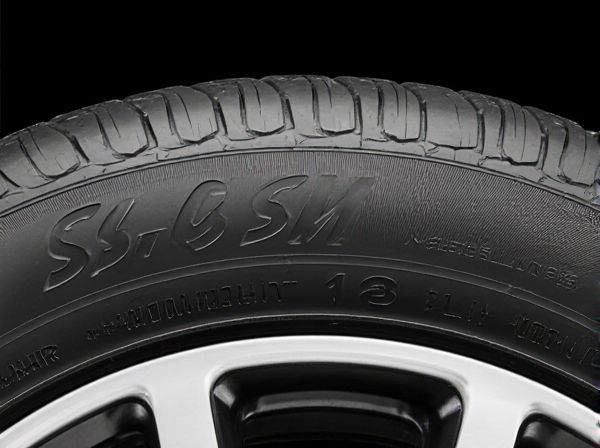
Photo illustration: Speed Rating vs Load Rating
Speed rating indicates the maximum safe speed a tire can maintain, while load rating specifies the maximum weight a tire can support. Ensuring your tires match both ratings is crucial for safe driving performance and vehicle handling. Your choice directly impacts safety, tire longevity, and overall driving experience.
Table of Comparison
| Rating Type | Definition | Measurement Unit | Key Value | Importance | Example |
|---|---|---|---|---|---|
| Speed Rating | Maximum speed a tire can safely maintain | Miles per hour (mph) / Kilometers per hour (km/h) | Letters (e.g., S=112 mph, H=130 mph, V=149 mph) | Ensures tire performance at specific speeds | H = 130 mph (210 km/h) |
| Load Rating | Maximum weight a tire can support | Pounds (lbs) / Kilograms (kg) | Numeric Index (e.g., 95=1,521 lbs) | Ensures vehicle safety under weight stress | 95 = 1,521 lbs (690 kg) |
Introduction to Tire Speed and Load Ratings
Tire speed ratings indicate the maximum speed a tire can safely sustain, represented by letters such as H, V, or Z, which correspond to specific speed limits. Load ratings define the maximum weight each tire can carry, quantified by numerical codes linked to precise weight capacities in pounds or kilograms. Understanding both ratings is crucial for selecting tires that match vehicle performance requirements and ensure safety under various driving conditions.
Understanding Speed Ratings: Definition and Types
Speed rating indicates the maximum safe speed a tire can sustain over time without failure, categorized by letters such as S (112 mph), H (130 mph), and V (149 mph). This rating is crucial for matching tires to vehicle performance, ensuring safety and optimizing tire lifespan. Understanding these types helps drivers select appropriate tires aligned with their driving conditions and manufacturer specifications.
Decoding Load Ratings: What Do They Mean?
Load ratings indicate the maximum weight a tire can safely support, specified in pounds or kilograms, essential for maintaining vehicle stability and safety. Speed ratings represent the highest speed a tire can sustain under specified conditions, denoted by letters such as H, V, or Z, which correspond to precise speed limits in miles or kilometers per hour. Decoding load ratings involves matching the tire's load index number to a standardized chart, ensuring compatibility with the vehicle's maximum load requirements without compromising performance or safety.
Key Differences Between Speed and Load Ratings
Speed rating indicates the maximum speed a tire can safely sustain, marked by letters such as H, V, or Z, while load rating represents the maximum weight a tire can support, measured in pounds or kilograms. Understanding these distinct metrics is crucial for selecting tires that match vehicle performance and safety requirements. Properly matching both speed and load ratings ensures optimal tire durability, handling, and safety under expected driving conditions.
Importance of Matching Speed and Load Ratings to Your Vehicle
Matching your vehicle's speed rating and load rating is crucial for maintaining safety, performance, and tire longevity. Speed rating indicates the maximum speed a tire can safely sustain, while load rating specifies the maximum weight the tire can carry. Using tires with inadequate speed or load ratings can compromise handling, increase wear, and risk tire failure under normal driving conditions.
How to Identify Tire Speed and Load Ratings
Tire speed ratings are identified by a letter on the tire sidewall, representing the maximum safe speed the tire can maintain, such as H (130 mph) or V (149 mph). Load ratings are indicated by a numerical code, correlating to the maximum weight each tire can support, like 91 (615 kg) or 100 (800 kg). To correctly identify these ratings, locate the alphanumeric sequence on the tire's sidewall, where the load index precedes the speed rating letter, ensuring the tire meets the vehicle's performance and safety requirements.
Impact of Incorrect Ratings on Performance and Safety
Incorrect speed ratings on tires can lead to reduced vehicle handling and increased risk of blowouts due to overheating, compromising overall safety. Load ratings that are too low for the vehicle's weight cause excessive tire wear and potential tire failure under heavy loads. Ensuring accurate speed and load ratings is essential for optimal tire performance, stability, and safety on the road.
Factors Influencing Speed and Load Rating Requirements
Speed rating and load rating of tires are influenced by factors such as vehicle type, driving conditions, and safety standards. High-performance vehicles demand higher speed ratings to maintain stability at elevated speeds, while heavier vehicles require greater load ratings to support weight safely. Environmental conditions and regulatory requirements also shape the necessary speed and load ratings to ensure optimal tire performance and durability.
Frequently Asked Questions About Speed vs Load Ratings
Speed rating indicates the maximum safe driving speed for a tire, while load rating defines the tire's maximum weight capacity. Common questions often address how to choose tires matching both ratings for vehicle safety and performance. Understanding these ratings helps ensure optimal tire durability and handling under specific driving conditions.
Conclusion: Choosing the Right Ratings for Optimal Performance
Selecting the appropriate speed rating and load rating is crucial for ensuring tire performance, safety, and longevity. Speed ratings indicate the maximum speed a tire can safely handle, while load ratings define the maximum weight capacity per tire. Prioritizing both ratings according to your vehicle specifications optimizes handling, fuel efficiency, and durability.
 caratoz.com
caratoz.com